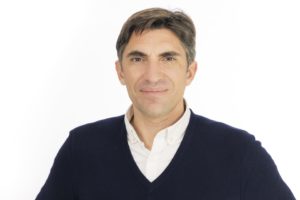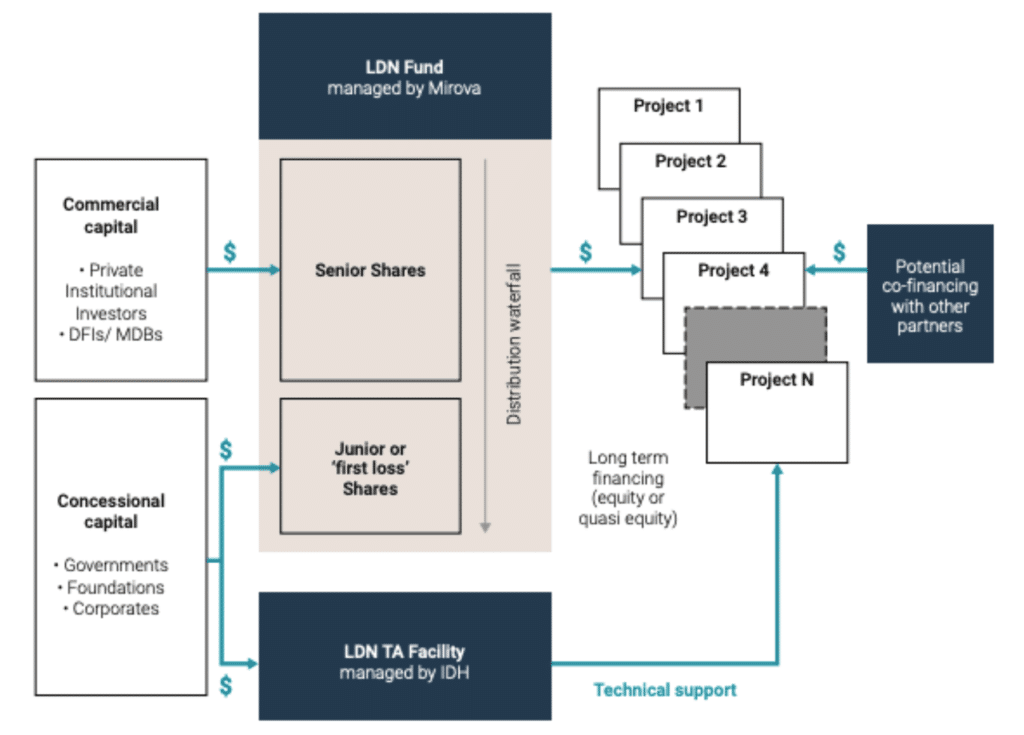| Title | Mirova Land Degradation Neutrality Fund |
| Country/Location | France |
| Size | >$208m |
| Revenue Model | Providing long-term loans or equity to profit-generating enterprises in developing countries that are improving sustainability and efficiency through sustainable land use and land restoration |
| Private Investment/Finance Structure | Private equity investment |
| Public/Philanthropic Investment | Concessional capital from public and private investors |
| Env/Social Impact | Restoring degraded lands, mitigating climate change, protecting biodiversity and vital ecosystems, creating jobs and empowering sustainable businesses, improving rural development and gender equality |
Two billion hectares of land are degraded around the world, a result of over-intensive farming and deforestation, and another 12 million hectares of productive land is degraded every year. This not only exacerbates climate change, but impoverishes communities, reduces biodiversity and increases food insecurity.
Attaining land degradation neutrality by 2030, which the United Nations’ Convention to Combat Desertification (UNCCD) defines as “a state whereby the amount and quality of land resources necessary to support ecosystem functions and services and enhance food security remains stable or increases”, is a critical priority and a UN Sustainable Development Goal.
To address a problem of this scale, new financial instruments were needed to generate interest from investors, particularly private investors, and to convince them that restoring degraded lands was a viable investment opportunity, rather than a challenge for local communities to resolve.
So in 2015, the UNCCD came up with the idea of a Land Degradation Neutrality Fund to offer an effective way for the market to invest in sustainable land use. The UNCCD selected Mirova to structure, capitalise and independently manage the fund, and after three years of preparatory work, the Land Degradation Neutrality (LDN) Fund became fully operational in December 2018. It is the first fund globally that is dedicated to preventing soil degradation.
The LDN Fund is an impact investment fund that invests in profit-generating sustainable land use and land restoration projects, mostly in developing countries. The fund has active investments in Latin America, Sub-Saharan Africa and Asia, and in March 2021, the fund reached its final closing, with more than $200 million committed by public and private investors.
A blended finance structure
The fund is reserved for institutional investors and is a blended finance vehicle, with two categories of shares – a junior tranche of concessional capital that derisks the senior tranche of commercial capital. Public and private investors are involved in both categories.

Gautier Quéru, Director of the LDN Fund
“Most of the commercial capital is from private institutional investors, but there are also some development finance institutions, such as the European Investment Bank, in the commercial category,” says Gautier Quéru, Director of the LDN Fund. “They are investing alongside private investors to encourage more private investment.” He adds that the junior tranche includes national governments, such as the British and Canadian governments, plus some private foundations and impact investors.
Private investors, including Allianz France, BNP Paribas Cardif and BRED Banque Populaire, now account for over 60% of the fund’s total commitment, but Quéru says the participation of concessional investors was crucial to convince investors seeking market returns to participate. “This is really catalytic funding. Without the concessional capital, the commercial capital would not have come in, because of the novelty of the asset class and its high risk perception,” he says.
However, putting this blended model together was a big challenge. “Blended finance is great in principle, but turning that principle into concrete operations, legal documentation, risk and profit sharing is challenging, especially when there are many players around the table,” says Quéru.
The 15-year fund, which has an investment period of five years, provides long-term loans or equity investments, plus technical assistance, to profit-making enterprises involved in sustainable land use and land restoration on degraded lands. These are mostly in the agroforestry and sustainable forestry sectors. Land restoration projects are usually financed with long-term loans, but when projects offer lots of value creation potential beyond just restoration, the fund can also invest equity.
In either case, the LDN Fund invests in profitable projects with the aim of delivering competitive returns for investors. The fund creates value by improving those enterprises’ sustainability and efficiency, through sustainable forestry production, for example, which increases quality and prices. Another method is to improve market access through sustainable supply chains. The fund will only invest in projects that can make a significant contribution to land degradation neutrality while producing appropriate risk-adjusted returns and complying with robust environmental and social standards.
By supporting enterprises working in sustainable land use and restoration, the fund is empowering sustainable businesses and creating jobs; mitigating climate change; protecting biodiversity and restoring vital ecosystems; improving rural development and the resilience of local communities; and boosting gender equality. According to its first impact report published in 2001, the fund’s impact targets include creating 70,000 jobs through the enterprises and projects it supports, putting 350,000 hectares of land under sustainable management, and sequestering 25 million tonnes of carbon.
To date, the fund has invested in eight countries, including sustainable coffee and cocoa production projects, the restoration of deforested areas in Latin America, and forestry projects and tree nut production in Africa and Asia. The fund has a technical assistance facility that strengthens the project pipeline by helping projects to meet the LDN Fund investment criteria, while supporting projects post-investment to reduce project risks and increase positive social and environmental impacts.
Providing capital to smallholders
In each case, the fund tries to channel capital to smallholders, who typically don’t have access to finance, through local financial institutions and intermediaries who commit to promoting LDN-relevant sustainable land use among small- and mid-sized producers.
In 2020, for example, it made a 10-year investment in Mountain Hazelnuts in Bhutan, a company that since 2009, has bought the nuts from sustainable hazelnut orchards on degraded mountain slopes from growers for a guaranteed price. This has provided long-term income for vulnerable rural communities, while restoring the land. In 2020, the fund also made a eight-year investment in Komaza in Kenya, a sustainable forestry company that offers planting material and expertise to existing landowners so that they can grow trees on their land. Komaza also buys the wood at fair prices and manages the harvesting, processing and trading.
The LDN Fund now wants to diversify its portfolio to show that there are multiple ways of restoring degraded land, while generating impact and value. “We’re looking at pharmaceutical plants, for example, and fruit and vegetable production,” says Quéru. “We’re looking at primary production, but also processing and even direct sales to end consumers, because there are value creation opportunities through vertical integration into the supply chain.” The fund also wants to expand into new geographies, and explore opportunities in semi-arid areas, such as North Africa.
In the coming years, the aim is to build sustainable land use financing into a real investment theme, or asset class, so that public money is not needed any more. To that end, the LDN Fund is encouraging other players to join forces to build a sustainable land use financing sector. Quéru also thinks that the Natural Capital Investment Alliance, which enables companies to share best practice and better define the risk return profiles across all asset classes within natural capital investing, will help to build interest in this area.
He points out that the LDN Fund could also enhance its profits in the future, because projects that restore land and biodiversity also sequester carbon from the atmosphere, and can be eligible to sell carbon credits. “That additional source of revenue would make investment in the underlying projects we support even more attractive to investors in our fund,” he says.
In the short-term, though, the fund is focused on demonstrating a successful track record to encourage the establishment of similar funds. “This will give confidence to investors in the market,” says Quéru. “We encourage other players to come.”
Sources:
Land Degradation Neutrality Fund, Impact Report, 2021
Mirova.com
Interview with Gautier Quéru, Director of the LDN Fund
